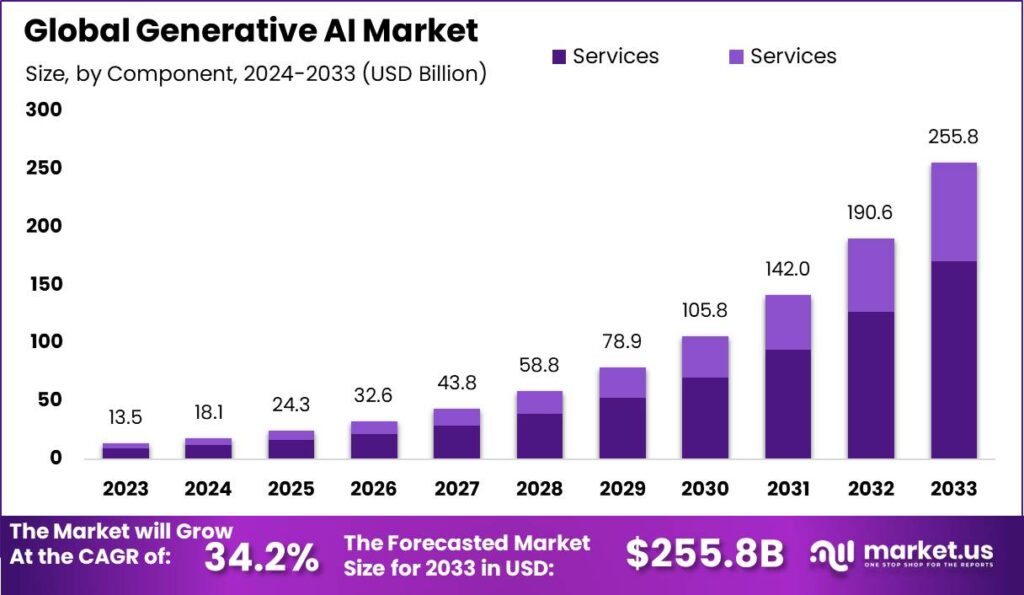WHAT WE HAVE ON THIS PAGE
- Market Insights
- Key Takeaways
- Generative AI Statistics
- Rise of Generative AI
- The Role of Generative AI
- Innovations Driving Generative AI
- ROI and Business Investment
- Regional Adoption of Generative AI
- Interest by region
- Interest Over Time
- Emerging Trends
- Top Use Cases
- Attractive Opportunities
- Top Key Players in the Market
Market Insights
According to the research conducted by Market.us, The Global Generative AI Market is projected to grow significantly, reaching approximately USD 255.8 billion by 2033, compared to USD 13.5 billion in 2023. This expansion reflects a robust CAGR of 34.2% between 2024 and 2033. North America led the market in 2023, securing a dominant share of 42.1%, with a revenue of USD 5.6 billion. This strong position is largely due to the rapid adoption of AI technologies, increasing investments from tech giants, and a well-established infrastructure supporting AI-driven innovation.
Generative Artificial Intelligence (AI) refers to advanced AI systems capable of creating synthetic data that closely resembles authentic data. This AI category encompasses technologies like Generative Adversarial Networks (GANs), Variational Autoencoders (VAEs), and autoregressive models. These systems excel in tasks such as content creation, data augmentation, and more, across diverse industries including healthcare, entertainment, and finance.
The growing demand for AI-powered content creation, automation, and advanced data processing is expected to drive the market forward. Companies across industries are increasingly leveraging generative AI to enhance efficiency, reduce costs, and improve customer experiences. As businesses continue to integrate AI solutions, the market is set for steady and transformative growth over the next decade.

Key drivers propelling the generative AI market include the escalating demand for personalized content, enhancements in customer engagement through predictive analytics, and the growing need for automating creative processes in industries like marketing and product design. Additionally, the increasing integration of AI in business operations for data-driven decision making significantly contributes to the market’s expansion.
The demand for generative AI is robust across sectors such as financial services, healthcare, and manufacturing, with particular growth potential noted in emerging technologies like AI-driven predictive maintenance and personalized product offerings. Investment opportunities are particularly prominent in startups and collaborations that focus on innovating AI applications and improving existing AI infrastructures.
Regulatory environments, ethical considerations regarding AI use, and technical challenges like data security and model reliability are major factors impacting the generative AI market. These challenges necessitate ongoing research and adaptation to ensure that generative AI solutions are both effective and compliant with global standards. Businesses leveraging generative AI gain competitive advantages through enhanced customer experiences, increased operational efficiency, and accelerated innovation cycles. These technologies enable companies to optimize product designs, improve decision-making processes, and generate new revenue streams through innovative AI-driven solutions.
Key Takeaways
- The Generative AI Market generated USD 13.5 billion in revenue in 2023 and is expected to reach USD 255.8 billion by 2033.
- The market is projected to grow at a CAGR of 34.2%.
- The Software segment dominated in 2023, accounting for 66.7% of revenue.
- The Transformer technology segment held a 45.1% share, with a projected CAGR of 32.2%.
- Large Language Models led the model segment, while Computer Vision is expected to grow the fastest, driven by transportation and surveillance applications.
- The Media & Entertainment sector dominated, holding a 24.3% market share.
- NLP led the market in 2023 by application and is projected to sustain growth.
- Computer Vision is expected to expand rapidly, driven by its adoption across industries.
- North America led the market, holding a 42.1% share.
Generative AI Statistics
- OpenAI is the largest generative AI company by both value and user base.
- Over 60% of companies incorporate generative AI in the workplace.
- 12% of U.S. adults have used ChatGPT for text generation.
- 30% of outbound marketing messages from large organizations will be AI-generated.
- Generative AI is expected to reduce workload by 60% to 70%.
- 92% of Fortune 500 firms have already adopted generative AI.
- 70% of Gen Z have experimented with generative AI tools.
- Nearly 9 out of 10 American jobs could be impacted by generative AI.
- 95% of customer interactions may involve AI by 2025.
- 73% of marketing departments use generative AI.
- AI could generate up to 97 million jobs by 2025.
Rise of Generative AI
The ascent of generative AI is marked by its transformational impact on various sectors, characterized by its rapid adoption and the integration of AI in core business processes. The generative AI market has demonstrated a sharp growth trajectory, driven by its ability to innovate and enhance productivity across diverse domains such as content creation, customer service, and product development. The technology’s capacity to automate and optimize tasks traditionally requiring human creativity has established it as a cornerstone of modern digital strategies.
The Role of Generative AI
Generative AI plays a pivotal role in today’s technological landscape by enabling the automation of creative processes, enhancing data analysis, and facilitating decision-making processes. It supports businesses in generating novel content, designing complex digital environments, and tailoring services to individual customer preferences, thereby enhancing user experiences and operational efficiencies. In industries like marketing, entertainment, and design, generative AI tools are used to produce highly personalized and engaging content, fundamentally altering how products are marketed and consumed.
Innovations Driving Generative AI
The driving force behind the rapid growth of generative AI includes continuous advancements in machine learning algorithms, particularly in deep learning networks such as GANs (Generative Adversarial Networks) and transformer models. These technologies have been pivotal in developing more realistic and complex outputs in fields such as image generation, natural language processing, and autonomous systems.
Innovations also stem from increasing computational power and the availability of large datasets, which are essential for training more effective generative models. Additionally, the rise of cloud computing and the development of AI-as-a-Service platforms have made these powerful tools accessible to a broader range of users and industries, fueling further innovation and adoption.
ROI and Business Investment
- Every $1 invested in generative AI yields an average ROI of 3.7x.
- Financial services have the highest generative AI ROI at 4.2x.
- Media and Telecommunications follow with a 3.9x ROI.
- 72% of companies use generative AI for multiple business functions.
- 92% of companies leverage generative AI for marketing and PR.
- 60% of organizations expect to fully utilize generative AI within the next 24 months.
- Only 30% or fewer of generative AI experiments move into production for 7 out of 10 organizations.
- 45% of technology infrastructure companies and 41% of data management firms feel prepared to adopt generative AI.
- Most companies plan to invest over 5% of their digital budgets in generative AI.
- Generative AI adoption rose from 55% in 2023 to 72% in 2024.
- 34% of companies using generative AI reported significant productivity gains.
- 67% of organizations are increasing generative AI investments compared to last year.
- Businesses adopting generative AI could achieve 15.2% cost savings.
- 10% of companies with annual revenue between $1 billion and $5 billion have implemented generative AI.
- Organizations invested an average of $110 million in generative AI initiatives in 2024
Regional Adoption of Generative AI
The adoption of generative AI varies significantly across regions, with some countries witnessing widespread usage while others show a more gradual integration.
- India leads in adoption, with 73% of the surveyed population actively using generative AI. This high adoption rate can be attributed to the increasing digital transformation, strong IT sector, and growing AI-driven applications in businesses and daily life.
- Australia follows, with 49% of the surveyed population utilizing generative AI. The rise in AI adoption is supported by advancements in automation, digital content creation, and enterprise solutions.
- The United States has a 45% adoption rate, driven by innovation in tech industries, AI-powered business solutions, and increasing consumer engagement with AI applications.
- The United Kingdom records a 29% adoption rate, reflecting a steady but slower integration of AI into business operations and consumer applications.
Interest by region

Interest Over Time

Source: Google Trends
Emerging Trends
- Hyper-Personalization: The advancement in Generative AI is ushering in an era of personalized user experiences, where services are tailored to individual preferences and behaviors, enhancing engagement and satisfaction across various sectors.
- Multimodal AI Applications: AI systems that integrate and process information from multiple types of data – text, images, audio, and video – are gaining traction, particularly in enhancing interactions within sectors like healthcare, retail, and customer service.
- AI-Driven Automation: Increasingly, generative AI is being deployed to automate complex and repetitive tasks, improving efficiency in industries such as manufacturing and customer service, where it helps in handling inventory, order processing, and customer inquiries.
- Advanced Conversational AI: Improvements in natural language processing are enabling more sophisticated conversational AI that can understand and respond to human nuances more effectively, thereby transforming customer service interactions.
- AI Ethics and Regulation: As AI becomes more prevalent, there is a growing focus on the ethical implications and the need for robust regulatory frameworks to ensure that AI development is aligned with societal values and privacy concerns.
Top Use Cases
- Healthcare: Generative AI is revolutionizing patient care by enhancing diagnostics, personalizing treatment plans, and accelerating drug discovery, offering significant improvements in treatment outcomes.
- Content Creation: In media and entertainment, AI tools are being utilized to generate written content, graphics, and even music, streamlining creative processes and allowing for more scalable content production.
- Customer Support: AI-powered chatbots and virtual assistants, equipped with advanced conversational abilities, are being used to provide 24/7 customer support, enhancing user experience while reducing operational costs.
- Marketing and Sales: Generative AI is enabling hyper-personalized marketing campaigns and dynamic sales strategies, analyzing customer data to deliver tailored advertisements and promotions.
- Software Development: AI is increasingly involved in software engineering, from generating code snippets to aiding in system testing, significantly boosting developer productivity and reducing time to market.
Attractive Opportunities
- Sustainability Initiatives: AI’s role in enhancing environmental sustainability through optimized resource management, smarter energy systems, and advanced recycling technologies presents significant growth opportunities.
- Educational Tools: The development of AI-driven educational content that adapts to the learning pace and style of students offers potential for substantial impact in the educational sector.
- Financial Services: In finance, generative AI is being used for risk assessment, fraud detection, and personalized banking services, improving security and customer service.
- Legal and Compliance: AI applications that help manage compliance and navigate the complex landscape of regulations are becoming increasingly crucial as industries face stricter regulatory environments.
- Retail Innovations: In retail, AI is transforming the shopping experience through virtual fitting rooms and personalized shopping assistants, driving sales and enhancing customer satisfaction.
Top Key Players in the Market
- IBM Corporation
- Genie AI Ltd.
- MOSTLY AI Inc.
- Google LLC
- D-ID
- Amazon Web Services Inc.
- Microsoft Corporation
- Adobe Inc.
- Synthesia
- Other Key Players
Sources:
- https://www.aiprm.com/en-gb/generative-ai-statistics/
- https://mspoweruser.com/generative-ai-statistics/
- https://explodingtopics.com/blog/generative-ai-stats
- https://www.salesforce.com/news/stories/generative-ai-statistics/
- https://www.amplifai.com/blog/generative-ai-statistics
- https://scoop.market.us/generative-ai-market-news/
ABOUT AUTHOR
Yogesh Shinde is a passionate writer, researcher, and content creator with a keen interest in technology, innovation and industry research. With a background in computer engineering and years of experience in the tech industry. He is committed to delivering accurate and well-researched articles that resonate with readers and provide valuable insights. When not writing, I enjoy reading and can often be found exploring new teaching methods and strategies.










